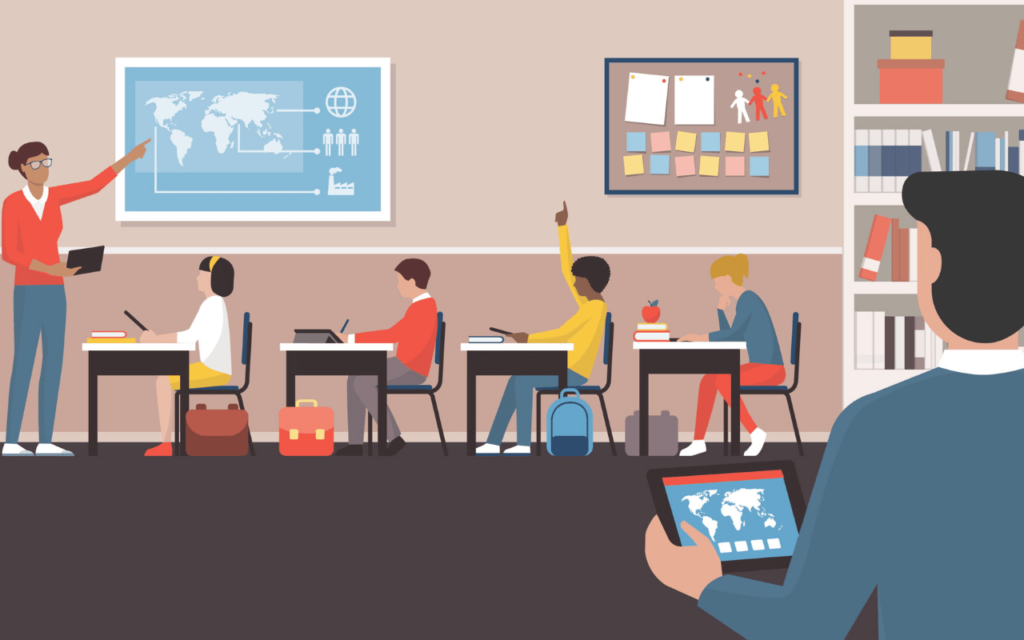Teachers: In the fast-paced evolution of education, the traditional classroom is undergoing a profound transformation, propelled by the integration of digital technologies. The advent of the social classroom heralds an era where students and teachers engage in a dynamic, interconnected learning environment. In this exploration of “The Social Classroom,” we delve into the intricate tapestry of the digital age, where human connection, collaboration, and innovative teaching methods intertwine to redefine the educational landscape.
Evolution of the Traditional Classroom
Beyond Four Walls
- Shifting Paradigms: The social classroom represents a departure from the traditional four walls of learning. It embraces the expansive digital realm, recognizing that education extends beyond physical boundaries.
- Student-Centric Focus: The focal point shifts from a teacher-centric approach to one that is student-centered. The social classroom emphasizes personalized learning, catering to individual needs and fostering a sense of ownership in students.
Defining the Social Classroom in the Digital Age
Connectivity and Collaboration
- Digital Connectivity: The essence of the social classroom lies in digital connectivity. Students and teachers are connected in real-time through various platforms, creating a web of communication that transcends the limitations of physical proximity.
- Collaborative Learning Spaces: Online platforms and tools create collaborative learning spaces where students can interact, share ideas, and engage in projects. The social classroom becomes a hub for collective knowledge creation and exchange.
Components of the Social Classroom
Twitter: A Microcosm of Educational Dialogue
- Educational Chats: Twitter serves as a microblogging platform for educational dialogue. Teachers and students engage in educational chats, using hashtags like #EdChat or #StudentVoices to share insights, pose questions, and participate in broader conversations.
- Real-Time Updates: The instantaneous nature of Twitter allows for real-time updates, keeping both students and teachers informed about educational trends, events, and relevant news.
Online Forums: Virtual Spaces for Discussion
- Extended Classroom Discussions: Online forums provide an extension of classroom discussions. Students can pose questions, share resources, and engage in thoughtful conversations beyond the confines of the physical classroom.
- Teacher-Moderated Spaces: Moderated by teachers, these forums maintain a structured environment where constructive discussions flourish, creating an inclusive digital space for intellectual exchange.
Virtual Classrooms: Breaking Geographic Barriers
- Global Perspectives: Virtual classrooms break down geographical barriers, exposing students to global perspectives. Collaborative projects with students from different parts of the world become a reality, broadening cultural understanding and enhancing the learning experience.
- Interactive Learning Tools: Incorporating interactive learning tools within virtual classrooms adds a dynamic dimension to teaching. Virtual simulations, interactive presentations, and multimedia content enhance engagement and cater to diverse learning styles.
Learning Management Systems (LMS): A Hub for Educational Resources
- Centralized Resource Repository: Learning Management Systems act as a centralized repository for educational resources. Teachers can upload materials, assignments, and assessments, providing students with easy access to learning materials.
- Individualized Learning Paths: LMS platforms enable teachers to create individualized learning paths, tailoring the educational journey to each student’s pace and preferences. This customization fosters a sense of autonomy in learning.
The Human Touch in the Social Classroom
Teacher as Facilitator and Mentor
- Facilitating Discussions: In the social classroom, the teacher assumes the role of a facilitator. Instead of being the sole source of information, they guide discussions, encourage critical thinking, and create an environment where students actively contribute to the learning process.
- Mentoring Digital Etiquette: Teachers play a crucial role in mentoring digital etiquette. They instill principles of online responsibility, respectful communication, and the importance of constructive feedback, ensuring a positive and inclusive digital learning environment.
Fostering Student Collaboration
- Project-Based Collaborations: The social classroom encourages project-based collaborations among students. Whether through shared documents, collaborative presentations, or virtual group projects, students develop essential teamwork and communication skills.
- Peer-to-Peer Learning: Peer-to-peer learning thrives in the social classroom. Students become both learners and educators, sharing their expertise and insights with peers, fostering a culture of knowledge exchange.
Challenges and Solutions in the Social Classroom
Digital Literacy Education
- Embedding Digital Literacy: The integration of digital literacy education is paramount. Teachers guide students in navigating the digital landscape responsibly, teaching them to critically evaluate online information and engage in ethical online behavior.
- Continuous Professional Development: Teachers undergo continuous professional development to stay abreast of technological advancements. Workshops, online courses, and collaborative learning communities empower educators to effectively leverage digital tools in the classroom.
Digital Equity and Inclusivity
- Addressing Digital Disparities: The social classroom strives for digital equity. Schools implement initiatives to address disparities in access to technology, ensuring that all students, regardless of socioeconomic background, can participate fully in the digital learning experience.
- Inclusive Design: Teachers employ inclusive design principles when creating online content. This includes providing alternative formats for materials, accommodating various learning styles, and ensuring that digital resources are accessible to all students.
The Future of Education: Social Classroom Innovations
Augmented Reality (AR) and Virtual Reality (VR) Integration
- Immersive Educational Experiences: The integration of AR and VR technologies promises immersive educational experiences. Virtual field trips, historical reenactments, and interactive simulations bring learning to life, making subjects more engaging and memorable.
- Virtual Laboratories: In the social classroom, virtual laboratories powered by AR and VR offer students the opportunity to conduct experiments in a simulated environment. This hands-on approach enhances understanding and practical application of scientific concepts.
Artificial Intelligence (AI) for Personalized Learning Paths
- Adaptive Learning Platforms: AI-driven adaptive learning platforms analyze student performance data to create personalized learning paths. These platforms identify areas of strength and weakness, tailoring educational content to individual needs for optimized learning outcomes.
- Intelligent Tutoring Systems: Intelligent tutoring systems powered by AI provide real-time feedback and support. Students receive personalized guidance, allowing them to progress at their own pace while receiving targeted assistance in challenging areas.
In Conclusion: The Human-Centric Digital Classroom
As we navigate the era of the social classroom, the fusion of technology and human connection emerges as the driving force. In this humanized digital landscape, teachers become mentors, students become collaborators, and the traditional boundaries of education dissolve.
The social classroom represents a paradigm shift, where the emphasis is not just on the adoption of technology but on harnessing its potential to enhance the human aspects of education. As we look toward the future, the social classroom stands as a testament to the transformative power of digital innovation, fostering a learning environment where the human touch remains at the heart of educational endeavors. In this digital age, the classroom is not just social; it is a vibrant, collaborative space where students and teachers embark on a shared journey of discovery and growth.




